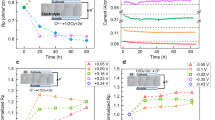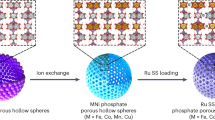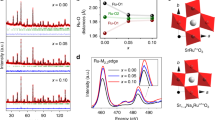Abstract
The growing need to store increasing amounts of renewable energy has recently triggered substantial R&D efforts towards efficient and stable water electrolysis technologies. The oxygen evolution reaction (OER) occurring at the electrolyser anode is central to the development of a clean, reliable and emission-free hydrogen economy. The development of robust and highly active anode materials for OER is therefore a great challenge and has been the main focus of research. Among potential candidates, perovskites have emerged as promising OER electrocatalysts. In this study, by combining a scalable cutting-edge synthesis method with time-resolved X-ray absorption spectroscopy measurements, we were able to capture the dynamic local electronic and geometric structure during realistic operando conditions for highly active OER perovskite nanocatalysts. Ba0.5Sr0.5Co0.8Fe0.2O3−δ as nano-powder displays unique features that allow a dynamic self-reconstruction of the material’s surface during OER, that is, the growth of a self-assembled metal oxy(hydroxide) active layer. Therefore, besides showing outstanding performance at both the laboratory and industrial scale, we provide a fundamental understanding of the operando OER mechanism for highly active perovskite catalysts. This understanding significantly differs from design principles based on ex situ characterization techniques.
This is a preview of subscription content, access via your institution
Access options
Access Nature and 54 other Nature Portfolio journals
Get Nature+, our best-value online-access subscription
$29.99 / 30 days
cancel any time
Subscribe to this journal
Receive 12 print issues and online access
$259.00 per year
only $21.58 per issue
Buy this article
- Purchase on Springer Link
- Instant access to full article PDF
Prices may be subject to local taxes which are calculated during checkout






Similar content being viewed by others
References
Fabbri, E., Habereder, A., Waltar, K., Kotz, R. & Schmidt, T. J. Developments and perspectives of oxide-based catalysts for the oxygen evolution reaction. Catal. Sci. Technol. 4, 3800–3821 (2014).
Kanan, M. W. & Nocera, D. G. In situ formation of an oxygen-evolving catalyst in neutral water containing phosphate and Co2+. Science 321, 1072–1075 (2008).
Smith, R. D. L. et al. Photochemical route for accessing amorphous metal oxide materials for water oxidation catalysis. Science 340, 60–63 (2013).
Bergmann, A. et al. Reversible amorphization and the catalytically active state of crystalline Co3O4 during oxygen evolution. Nat. Commun. 6, 8625 (2015).
Zhang, B. et al. Homogeneously dispersed, multimetal oxygen-evolving catalysts. Science 352, 333–337 (2016).
Vojvodic, A. & Norskov, J. K. Optimizing perovskites for the water-splitting reaction. Science 334, 1355–1356 (2011).
Suntivich, J., May, K. J., Gasteiger, H. A., Goodenough, J. B. & Shao-Horn, Y. A perovskite oxide optimized for oxygen evolution catalysis from molecular orbital principles. Science 334, 1383–1385 (2011).
Seitz, L. C. et al. A highly active and stable IrO2/SrIrO3 catalyst for the oxygen evolution reaction. Science 353, 1011–1014 (2016).
Mefford, J. T. et al. Water electrolysis on La1−xSrxCoO3−δ perovskite electrocatalysts. Nat. Commun. 7, 11053 (2016).
Han, B. et al. Nanoscale structural oscillations in perovskite oxides induced by oxygen evolution. Nat. Mater. 16, 121–126 (2017).
Fabbri, E., Nachtegaal, M., Cheng, X. & Schmidt, T. J. Superior bifunctional electrocatalytic activity of Ba0.5Sr0.5Co0.8Fe0.2O3−δ/carbon composite electrodes: insight into the local electronic structure. Adv. Energy Mater. 5, 1402033–1402037 (2015).
Müller, O., Nachtegaal, M., Just, J., Lutzenkirchen-Hecht, D. & Frahm, R. Quick-EXAFS setup at the SuperXAS beamline for in situ X-ray absorption spectroscopy with 10 ms time resolution. J. Synchrotron Radiat. 23, 260–266 (2016).
Heel, A., Holtappels, P., Hug, P. & Graule, T. Flame spray synthesis of nanoscale La0.6Sr0.4Co0.2Fe0.8O3−δ and Ba0.5Sr0.5Co0.8Fe0.2O3−δ as cathode materials for intermediate temperature solid oxide fuel cells. Fuel Cells 10, 419–432 (2010).
Arnold, M., Xu, Q., Tichelaar, F. D. & Feldhoff, A. Local charge disproportion in a high-performance perovskite. Chem. Mater. 21, 635–640 (2009).
Harvey, A. S. et al. Oxidation states of Co and Fe in Ba1−xSrxCo1−yFeyO3−δ (x, y = 0.2–0.8) and oxygen desorption in the temperature range 300–1273 K. Phys. Chem. Chem. Phys. 11, 3090–3098 (2009).
Jung, J.-I. et al. Optimizing nanoparticle perovskite for bifunctional oxygen electrocatalysis. Energy Environ. Sci. 9, 176–183 (2016).
Tung, C. W. et al. Reversible adapting layer produces robust single-crystal electrocatalyst for oxygen evolution. Nat. Commun. 6, 8106 (2015).
Binninger, T. et al. Electrochemical flow-cell setup for in situ X-ray investigations: I. Cell for SAXS and XAS at synchrotron facilities. J. Electrochem. Soc. 163, H906–H912 (2016).
Risch, M. et al. Structural changes of cobalt-based perovskites upon water oxidation investigated by EXAFS. J. Phys. Chem. C 117, 8628–8635 (2013).
May, K. J. et al. Influence of oxygen evolution during water oxidation on the surface of perovskite oxide catalysts. J. Phys. Chem. Lett. 3, 3264–3270 (2012).
Battle, P. D., Gibb, T. C. & Strange, R. A study of a new incommensurate phase in the system Srmn1-Xcoxo3-Y. J. Solid State Chem. 81, 217–229 (1989).
Gibb, T. C. Evidence for an unusual phase in the perovskite-related system BaCoxMn1−XO3−Y from EXAFS spectroscopy. J. Mater. Chem. 2, 387–393 (1992).
Totir, D., Mo, Y. B., Kim, S., Antonio, M. R. & Scherson, D. A. In situ CoK-edge X-ray absorption fine structure of cobalt hydroxide film electrodes in alkaline solutions. J. Electrochem. Soc. 147, 4594–4597 (2000).
Huang, J. et al. Oxyhydroxide nanosheets with highly efficient electron–hole pair separation for hydrogen evolution. Angew. Chem. Int. Ed. 55, 2137–2141 (2016).
Junheng, H., Qinghua, L., Tao, Y., Zhiyun, P. & Shiqiang, W. XAFS study on structure-activity correlations of α-Co(OH) 2 nanosheets water oxidation catalysts. J. Phys. Conf. Ser. 712, 012128 (2016).
Manceau, A. & Combes, J. M. Structure of Mn and Fe oxides and oxyhydroxides: a topological approach by EXAFS. Phys. Chem. Miner. 15, 283–295 (1988).
Pinakidou, F., Katsikini, M., Simeonidis, K., Paloura, E. C. & Mitrakasa, M. An X-ray absorption study of synthesis- and As adsorption-induced microstructural modifications in Fe oxy-hydroxides. J. Hazard Mater. 298, 203–209 (2015).
Chang, S. H. et al. Activity-stability relationship in the surface electrochemistry of the oxygen evolution reaction. Faraday Discuss. 176, 125–133 (2014).
Chang, S. H. et al. Functional links between stability and reactivity of strontium ruthenate single crystals during oxygen evolution. Nat. Commun. 5, 4191 (2014).
Binninger, T. et al. Thermodynamic explanation of the universal correlation between oxygen evolution activity and corrosion of oxide catalysts. Sci. Rep. 5, 12167 (2015).
Fierro, S., Nagel, T., Baltruschat, H. & Comninellis, C. Investigation of the oxygen evolution reaction on Ti/IrO2 electrodes using isotope labelling and on-line mass spectrometry. Electrochem. Commun. 9, 1969–1974 (2007).
Diaz-Morales, O., Calle-Vallejo, F., de Munck, C. & Koper, M. T. M. Electrochemical water splitting by gold: evidence for an oxide decomposition mechanism. Chem. Sci. 4, 2334–2343 (2013).
Kotz, R., Stucki, S., Scherson, D. & Kolb, D. M. In-situ identification of RuO4 as the corrosion product during oxygen evolution on ruthenium in acid-media. J. Electroanal. Chem. 172, 211–219 (1984).
Danilovic, N. et al. Activity–stability trends for the oxygen evolution reaction on monometallic oxides in acidic environments. J. Phys. Chem. Lett. 5, 2474–2478 (2014).
Cherevko, S. et al. Dissolution of noble metals during oxygen evolution in acidic media. ChemCatChem 6, 2219–2223 (2014).
Chaumont, R., Cheng, X. & Puente Orench, I. Effect of the Oxygen Vacancies and Crystalline Structure on the Oxygen Evolution Reaction Activity of Electrocatalysts Oxides (Institut Laue-Langevin (ILL), 2016).
McIntosh, S., Vente, J. P., Haije, W. G., Blank, D. H. A. & Bouwmeester, H. J. M. Oxygen stoichiometry and chemical expansion of Ba0.5Sr0.5Co0.8Fe0.2O3−d measured by in situ neutron diffraction. Chem. Mater. 18, 2187–2193 (2006).
Shao, Z. et al. Investigation of the permeation behavior and stability of a Ba0.5Sr0.5Co0.8Fe0.2O3−d oxygen membrane. J. Membr. Sci. 172, 177–188 (2000).
Švarcová, S., Wiik, K., Tolchard, J., Bouwmeester, H. J. M. & Grande, T. Structural instability of cubic perovskite BaxSr1−xCo1−yFeyO3−δ . Solid State Ion. 178, 1787–1791 (2008).
McIntosh, S., Vente, J. P., Haije, W. G., Blank, D. H. A. & Bouwmeester, H. J. M. Structure and oxygen stoichiometry of SrCo0.8Fe0.2O3−δ and Ba0.5Sr0.5Co0.8Fe0.2O3−δ . Solid State Ion. 177, 1737–1742 (2006).
Burke, M. S., Enman, L. J., Batchellor, A. S., Zou, S. & Boettcher, S. W. Oxygen evolution reaction electrocatalysis on transition metal oxides and (oxy)hydroxides: activity trends and design principles. Chem. Mater. 27, 7549–7558 (2015).
Friebel, D. et al. Identification of highly active Fe sites in (Ni, Fe)OOH for electrocatalytic water splitting. J. Am. Chem. Soc. 137, 1305–1313 (2015).
Gor̈lin, M. et al. Oxygen evolution reaction dynamics, faradaic charge efficiency, and the active metal redox states of Ni–Fe oxide water splitting electrocatalysts. J. Am. Chem. Soc. 138, 5603–5614 (2016).
Man, I. C. et al. Universality in oxygen evolution electrocatalysis on oxide surfaces. ChemCatChem 3, 1159–1165 (2011).
Ayers, K. E. et al. Pathways to ultra-low platinum group metal catalyst loading in proton exchange membrane electrolyzers. Catal. Today 262, 121–132 (2016).
Zhao, S. et al. Calculating the electrochemically active surface area of iridium oxide in operating proton exchange membrane electrolyzers. J. Electrochem. Soc. 162, F1292–F1298 (2015).
Berar, J. F. & Baldinozzi, G. XND code: from X-ray laboratory data to incommensurately modulated phases. Rietveld modelling of complex materials. CPD Newsletter 20, 29 (1998).
Ravel, B. & Newville, M. ATHENA, ARTEMIS, HEPHAESTUS: data analysis for X-ray absorption spectroscopy using IFEFFIT. J. Synchrotron. Radiat. 12, 537–541 (2005).
Acknowledgements
The authors gratefully acknowledge the Swiss National Science Foundation through its Ambizione Program (grant No. PZ00P2_148041 and grant No. PZ00P2_171426), the Swiss Competence Center for Energy Research (SCCER) Heat & Electricity Storage, the Swiss National Science Foundation within NCCR Marvel, and the Paul Scherrer Institute for financial contributions to this work. The authors thank I. Puente Orench from D1B/ILL/Grenoble for her assistance with the neutron diffraction experiments and R. Haumont from SP2M/ICMMO/Université Paris-sud for his help with neutron diffraction refinement. Furthermore, the authors thank the Swiss Light Source for providing beamtime at the SuperXAS beamline and ScopeM of ETH Zurich for the use of their transmission electron microscopes.
Author information
Authors and Affiliations
Contributions
E.F., T.B. and T.J.S. developed the concept. M.N. refined the argumentation. F.B. synthesized the nanocatalysts. E.F., X.C., B.-J.K. and J.D. carried out sample physical characterizations and electrochemical measurements. E.F., M.N., J.D. and X.C. carried out the experiments at the SuperXAS beamline. M.N. guided the operando XAS measurements. R.S. helped with the TEM investigation. L.W., M.P., N.D. and K.E.A. performed and supervised the electrolyser tests. E.F., M.N., T.B. and T.J.S. discussed the results and co-wrote the paper. All of the authors have revised the manuscript.
Corresponding authors
Ethics declarations
Competing interests
The authors declare no competing financial interests.
Supplementary information
Supplementary Information
Supplementary Information (PDF 2708 kb)
Rights and permissions
About this article
Cite this article
Fabbri, E., Nachtegaal, M., Binninger, T. et al. Dynamic surface self-reconstruction is the key of highly active perovskite nano-electrocatalysts for water splitting. Nature Mater 16, 925–931 (2017). https://doi.org/10.1038/nmat4938
Received:
Accepted:
Published:
Issue Date:
DOI: https://doi.org/10.1038/nmat4938
This article is cited by
-
Active learning guides discovery of a champion four-metal perovskite oxide for oxygen evolution electrocatalysis
Nature Materials (2024)
-
Surface oxidation/spin state determines oxygen evolution reaction activity of cobalt-based catalysts in acidic environment
Nature Communications (2024)
-
Best practices for operando hard X-ray absorption spectroscopy
Nature Sustainability (2024)
-
Perovskite Oxides Toward Oxygen Evolution Reaction: Intellectual Design Strategies, Properties and Perspectives
Electrochemical Energy Reviews (2024)
-
Accurate construction of cobalt vacancies in Co3O4 to promote oxyhydroxide formation for water oxidation
Science China Materials (2024)



